More About L1 Visa
Table of ContentsL1 Visa - An OverviewThe Of L1 VisaSome Known Facts About L1 Visa.The Buzz on L1 VisaTop Guidelines Of L1 VisaUnknown Facts About L1 Visa
Available from ProQuest Dissertations & Theses International; Social Scientific Research Costs Collection. DHS Office of the Inspector General. Recovered 2023-03-26.
United State Department of State. Gotten 2023-02-08. Tamen, Joan Fleischer (August 10, 2013).
The 3-Minute Rule for L1 Visa
In order to be eligible for the L-1 visa, the international firm abroad where the Recipient was utilized and the U.S. business must have a qualifying connection at the time of the transfer. The different kinds of qualifying connections are: 1. Parent-Subsidiary: The Parent implies a firm, firm, or various other lawful entity which has subsidiaries that it has and controls."Subsidiary" suggests a company, firm, or various other legal entity of which a parent owns, straight or indirectly, more than 50% of the entity, OR has less than 50% yet has management control of the entity.
Business A possesses 100% of the shares of Business B.Company A is the Parent and Firm B is a subsidiary. There is a qualifying connection in between the 2 firms and Firm B need to be able to fund the Recipient.
Company An owns 40% of Business B. The continuing to be 60% is owned and controlled by Company C, which has no relation to Company A.Since Company A and B do not have a parent-subsidiary relationship, Company A can not sponsor the Beneficiary for L-1.
Example 3: Business A is included in the united state and intends to seek the Beneficiary. Business B is included in Indonesia and utilizes the Recipient. Company A has 40% of Company B. The staying 60% is owned by Firm C, which has no relation to Company A. Nonetheless, Business A, by official arrangement, controls and complete takes care of Company B.Since Firm An owns much less than 50% of Firm B however handles and manages the business, there is a certifying parent-subsidiary partnership and Company A can sponsor the Beneficiary for L-1.
Indicators on L1 Visa You Should Know
Associate: An associate is 1 of 2 subsidiaries thar are both had and managed by the exact same moms and dad or individual, or possessed and controlled by the same group of individuals, in essentially the exact same proportions. a. Instance 1: Firm A is incorporated in Ghana and utilizes the Beneficiary. Business B is included in the united state
Firm C, likewise integrated in Ghana, owns 100% of Business A and 100% of Company B.Therefore, Business A and Firm B are "affiliates" or sister business and a qualifying relationship exists in between the 2 firms. Business B need to have the ability to fund the Recipient. b. Example 2: Firm A is integrated in the united state
Business A click here is 60% possessed by Mrs. Smith, 20% had by Mr. Doe, and 20% possessed by Ms. Brown. Firm B is integrated in Colombia and presently utilizes the Recipient. Business B is 65% possessed by Mrs. Smith, 15% possessed by Mr. Doe, and 20% possessed by Ms. Brown. Business A and Business B are affiliates and have a qualifying relationship in two different methods: Mrs.
The L-1 visa is an employment-based visa classification developed by Congress in 1970, allowing multinational business to transfer their managers, executives, or crucial personnel to their U.S. procedures. It is frequently described as the intracompany transferee visa. There are two main sorts of L-1 visas: L-1A and L-1B. These types appropriate for employees worked with in different settings within a company.

Furthermore, the beneficiary needs to have functioned in a supervisory, exec, or specialized staff member setting for one year within the three years preceding the L-1A application in the foreign firm. For brand-new workplace applications, international employment needs to have remained in a managerial or executive ability if the recipient is involving the United States to function as a manager or executive.
The 5-Minute Rule for L1 Visa

If provided for an U.S. firm functional for greater than one year, the preliminary L-1B visa is for approximately 3 years and can be extended for an additional two years (L1 Visa). On the other hand, if the U.S. company is newly developed or has been operational for much less than one year, the initial L-1B visa is released for one year, with expansions available in two-year increments
The L-1 visa is an employment-based visa category established by Congress in 1970, permitting international companies to transfer their supervisors, execs, or key personnel to their U.S. operations. It is typically referred read more to as the intracompany transferee visa.
Little Known Facts About L1 Visa.
Additionally, the recipient should have operated in a managerial, executive, or specialized staff member position for one year within click here the three years coming before the L-1A application in the foreign company. For new workplace applications, foreign work has to have remained in a supervisory or executive capability if the beneficiary is pertaining to the USA to function as a supervisor or executive.
for up to seven years to look after the operations of the united state associate as an executive or supervisor. If issued for an U.S. business that has been operational for more than one year, the L-1A visa is initially granted for up to 3 years and can be extended in two-year increments.
If provided for a united state company functional for even more than one year, the initial L-1B visa is for as much as three years and can be expanded for an extra 2 years. Conversely, if the U.S. company is newly established or has been operational for less than one year, the first L-1B visa is released for one year, with extensions offered in two-year increments.